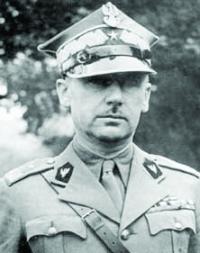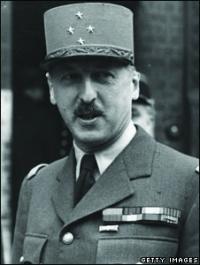
Susan Travers, the only woman to serve with the French Foreign Legion.

Stanislaw Kopanski

French Gen. Marie Pierre Koenig

Italian Gen. Benvenuto Gioda, Cmdr. X Corps.

French Colonial troops from, l-r, Senegal, Equitorial Africa and Madagascar, at Bir Hacheim.
This week, seventy years ago, the Panzerarmee Afrika began its assault on the Allied defensive line at El Gazala. The line stretched from El Gazala, a small Libyan village on the Mediterranean coast, thirty-eight miles west of Tobruk, for forty-five miles southwest into the desert.
After the siege of Tobruk had been lifted in December of 1941, the Axis had been driven out of the eastern part of Libya, known as Cyrenaica, and back to Marsa el-Brega, located in Tripolitania, on the Gulf of Sirte. Today, it has a population of 12,000.
Even as his army was retreating, Panzerarmee Afrika’s Commander, General Erwin Rommel, was planning his next offensive. The Axis had broken the American diplomatic code, and through the inquisitive American military attaché in Cairo, knew almost as much about the British Eighth Army as the British.
Without informing his superiors, and against the wishes of his Italian allies, General Rommel launched a second offensive on January 19, 1942, recapturing Msus, which the Allies were using as a supply depot, together with more than 600 trucks, 127 guns and 280 armored fighting vehicles. Agedabia was retaken on January 22, 1942. It is located about four miles inland from the eastern shore of the Gulf of Sirte, 100 miles south of Benghazi and 530 miles from the Libyan capital of Tripoli, and today is known as Ajdabia, with a population of 75,000.
On January 27, the Italian Duce and his Chief-of-Staff, General Ugo Cavallero, gave their permission to what was already a fait acompli - an Axis offensive. Cavallero was opposed, because he believed that the Axis did not have enough supplies for an advance. Benghazi was retaken the next day, together with more than 1300 trucks and large quantities of food and fuel.
Benghazi is a port city on the Mediterranean Sea, the second largest city in Libya, the capital of Cyrenaica and site of the origin of the recent anti-Ghaddafi uprising.
On February 3rd the coastal village of Timimi and the port of Derna were recaptured. Timimi currently has a population of about 4500 and is about sixty miles west of Tobruk, while Derna has a population of 81,000 and is located a little further west.
British Prime Minister Winston Churchill signaled his disappointment to Middle East Commander General Sir Claude Auchinleck - "The Auk" - that, "I am much disturbed by the report from the Eighth Army, which speaks of evacuation of Benghazi and Derna. I certainly have never been led to suppose that such a situation could arise."
General Rommel flew to Rome, thence to Germany for a month’s rest, on February 16. Before he arrived, der Führer bestowed the Knight’s Cross on General Cavallero. Luftwaffe Field Marshal Albert Kesselring had been transferred from the Eastern Front to Rome, where he was made Southern Commander-in-Chief on December 1, 1941. Fliegerkorps II, commanded by "Blue Max" and Knight’s Cross winner Bruno Loerzer, was transferred from the Eastern Front to Sicily, in January 1942. This resulted in the Axis achieving air superiority over the shipping lanes from Italy to Libya and getting most of their supplies, as the Luftwaffe and Regia Aeronautica bombed the British island of Malta, which lay astride those shipping lanes from Italy to Libya, into near extinction. As a result, on April 15, 1942, Britain’s King George VI awarded the George Cross to the island community in recognition of its heroism and endurance.
Meanwhile, the British Eighth Army, commanded by Neil Ritchie, was digging in, laying mines and fortifying "The Gazala Line." Although most of its officers were British, most of the soldiers - especially the infantry - were not. In addition to the British soldiers, there were Greeks, Indians, Nepalese, Poles, French and South Africans, divided amongst the XIII Corps commanded by William Gott, and the XXX Corps commanded by Charles Norrie. The XIII Corps included the First and Second South African Infantry Divisions commanded by Generals Daniel Pienaar and Hendrik Klopper, respectively, as well as the Fiftieth Infantry Division and the Polish Independent Brigade, commanded by William Ramsden and Stanislaw Kopañski.
The XXX Corps consisted of the First and Seventh Armored Divisions commanded by Herbert Lumsden and Frank Messervy. In addition, in reserve, the Eighth Army counted the Fifth and Tenth Indian Infantry Divisions commanded by Generals Rawdon Briggs and Thomas Rees.
The southern end of Eighth Army’s line was anchored at a remote oasis and an abandoned Turkish Fort named Bir Hacheim. The Allies strengthened their line with fortified positions which were called "boxes." The southern most box, at Bir Hacheim, was garrisoned by the 4000 man (plus one woman - Susan Travers) strong 1st Free French Brigade, under the command of Marie Pierre Koenig. The Brigade was comprised of Foreign Legionnaires and colonial troops. South of Bir Hacheim was open desert, so the British expected the Axis to swing around Bir Hacheim and they planned accordingly. Positions were prepared behind the French position at Bir Hacheim - but were not garrisoned, so as to not to be detected by Axis aerial reconnaisance.
Panzerarmee Afrika consisted of four Corps - the Deutsche Afrika Korps, the Italian XX Motorized, and the Italian X and XXI Infantry Corps, commanded respectively by Knight’s Cross winner Walter Nehring, Ettore Baldassare, Benvenuto Gioda and General Rommel’s "trusted friend," Enea Navarini.
The Deutsche Afrika Korps consisted of the 15th and 21st Panzer Divisions and the 90th Light Division, commanded by, respectively, Knight’s Cross winners Gustav von Värst, Georg von Bismarck and Ulrich Kleemann.
General Baldassare’s XX Motorized Corps, formally the Corpo D’Armata di Manovra, included the Ariete Armored and Trieste Motorized Infantry, Divisions, commanded by, respectively, Giuseppe de Stefanis and Arnaldo Azzi. General Baldassare had previously commanded the Ariete and was considered, by one of his field artillery officers, Caribinieri General (ret.) Franco LoSardo, to be a very good commanding officer. General Baldassare would die in the North African desert.
General Navarini’s XXI Corps consisted of the Pavia, Sabratha and Trento Infantry Divisions, commanded by, respectively, Arturo Torriano, Mario Soldarelli and Carlo Gotti, and a regiment of the elite Bersaglieri. General Gioda’s X Corps, included the Bologna and Brescia Infantry Divisions commanded by Alessandro Gloria and Giacomo Lombardi, and a second regiment of the elite Bersaglieri. The X and XXI Corps were under the command of German General Ludwig Crüwell, holder of the Knight’s Cross with Oak Leaves.
Panzerarmee Afrika counted only 332 German and 228 obsolete Italian tanks, as against the Eighth Army’s 900. Only 19 of the German tanks were armed better than the Allies’ best. And all of the Axis’ divisions were seriously under strength. But the German "Desert Fox" felt that it was now or never, because the imbalance would only continue to widen. But he had the advantage in audacity and air support.
On the evening of May 26, General Rommel led 10,000 vehicles of the Deutsche Afrika Korps and the Ariete Division around Bir Hacheim, while the rest of the Panzerarmee Afrika assaulted the Gazala Line to hold the Eighth Army in place. Ariete was peeled off to attack the French position the following day.
Within two days, the Axis armor had outrun its fuel supply. After General Azzi’s Trieste Division’s engineers cleared a path through the minefield between Bir Hachim and the rest of the Allied defenses, the Trieste punched a hole through the Allied line and brought in enough fuel to get the Axis vehicles moving again and save the day. A determined assault was made on the Gazala Line the next day by General Gioda’s X Corps from the west and the DAK from the east, which resulted in the Gazala Line being split in two and a better supply line to the Axis’ armor. Until that time, the two forces were like a double sandwich - from the west to east - Axis, Allies, Axis, Allies.
On June 2, Rommel sent the Trieste and 90th Light Divisions against Bir Hachim, with no success.
Eighth Army launched its armor at Panzerarmee Afrika, on June 5, but was savaged by the German 88s, losing 150 tanks. Five days later, the French abandoned Bir Hachim, having lost 1200. General Rommel said that, "In spite of all of our security measures, the greater part of the garrison broke out . . . under the leadership of their commander, General Koenig." Bir Hachim had held for 14 days and bought time for the 8th Army to escape
On June 14, "The Auk" signaled General Ritchie that, "Tobruk must be held!"
The next day, Axis’ armor reached the Mediterranean and General Rommel announced that, "The battle has been won and the foe is breaking up." By the following day, all Allied troops were gone from the Gazala Line, and except for those left to defend Tobruk, were headed back to Egypt. Commonwealth losses totaled 50,000 casualties and 1188 tanks. Axis losses totaled around 5000 casualties and 400 tanks. As important, in these desert battles, was the fact that the Axis troops held the field and were able to recover, and repair, the damaged machines.
NEXT WEEK: MIDWAY
Mr. Wimbrow writes from Ocean City, Maryland, where he practices law representing those persons accused of criminal and traffic offenses, and those persons who have suffered a personal injury through no fault of their own. Mr. Wimbrow can be contacted at wimbrowlaw@beachin.net
«Go back to the previous page.




